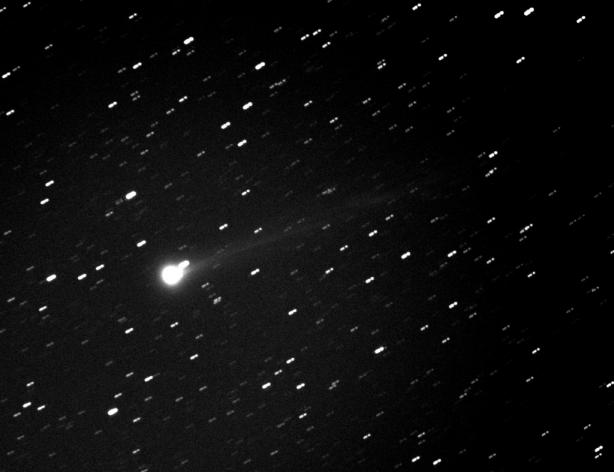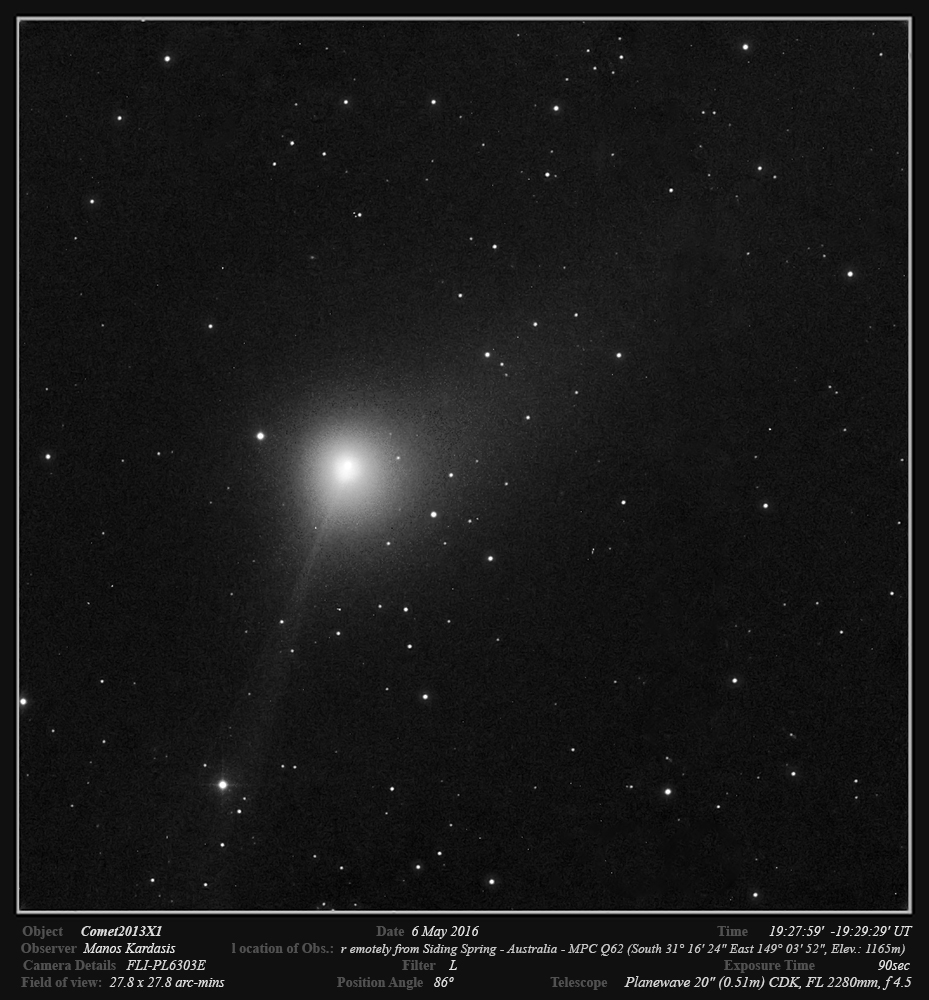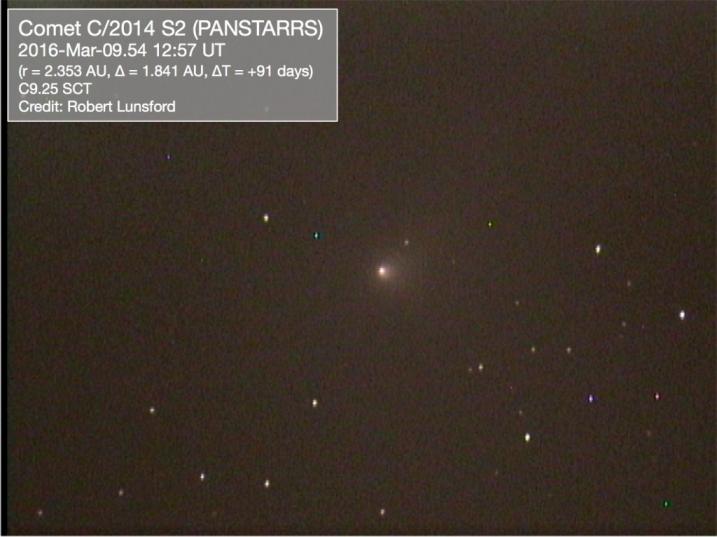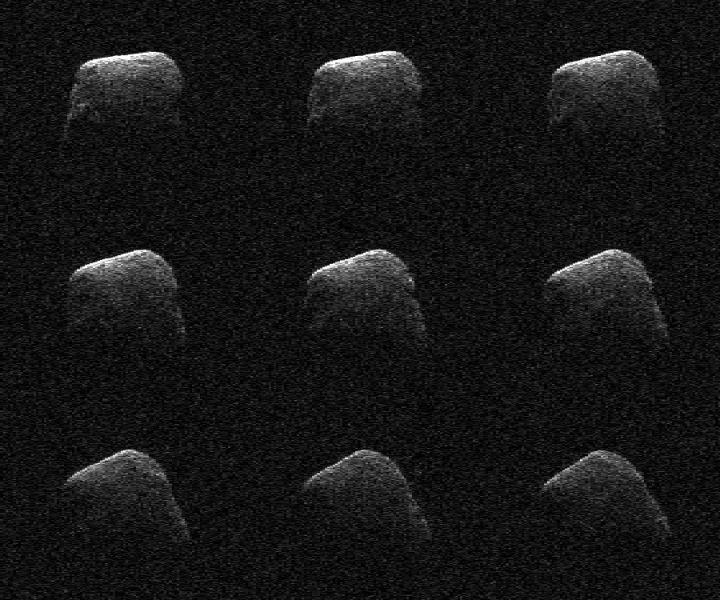ALPO COMET NEWS FOR FEB 2017
2017-February-11
Sorry for the late update. The big story this month is the extreme close approach of comet 45P/Honda-Mrkos-Pajdusakova to Earth on February 11 at 0.08 au. A few other comets, including frequent visitor 2P/Encke, will be visible in small telescopes.
Evening Comets
2P/Encke [Perihelion on 2017 March 10 at 0.34 au]
Comet Encke is making its 63rd observed apparition since it was first seen in 1786. Encke will become a visual object this February as it brightens from 10th to 7th magnitude in Pisces. Its elongation drops from 46 to 24 degrees. as its distance from the Sun decreases from 0.91 to 0.42 au and geocentric distance decreases from 1.27 to 0.81 au.
41P/Tuttle-Giacobini-Kresak [Perihelion on 2017 Apr 12 at 1.05 au]
This comet was discovered on three separate occasions: in 1858 by Horace Tuttle, 1907 by Michel Giacobini and 1951 by Lubor Kresak. 2017 marks 41P’s 11th observed apparition. Nominally 41P should become 6th magnitude by late March. I say nominally because this comet is prone to outbursts. In 1973, T-G-K experienced two 10-magnitude outbursts. Smaller outbursts also occurred in 1995 and 2001. If T-G-K were to experience an outburst during this return it could become a naked eye object. Perihelion is on April 13 at 1.05 au and close approach to Earth is on March 27 at 0.14 au. During February, T-G-K will brighten from 13th to 9th magnitude as it moves from 1.40 to 1.19 au from the Sun and 0.42 to 0.22 au from Earth. It will be located in Leo near opposition all month.
Morning Comets
45P/Honda-Mrkos-Pajdusakova [Perihelion on 2016 December 31 at 0.53 au]
Comet 45P/H-M-P brightened up to 6th magnitude before it was lost in the glow of dusk in early January. At that time is was highly condensed and displayed a hint of bluish-green in my 30×125 binoculars. The comet is currently racing higher into the eastern sky at dawn. Salvador Aguirre spotted it on Feb 10 at magnitude 6.5. A night earlier, I spotted it in 10×50s as a large diffuse glow over 1/2 degree across. Its appearance was very similar to that of 252P/LINEAR which made a close approach last year. Unfortunately, the best for this comet is probably over as large, diffuse, low surface brightness objects usually don’t fare well against a bright Moon. The comet will still be visible to small telescope and binocular observers throughout the month but will be fading (probably no brighter than 9th magnitude by the end of the month). This month, its heliocentric distance increases from 0.83 to 1.23 au while its geocentric distance initially decreases from 0.16 au to February 11’s close approach at 0.08 au and back to 0.25 au as it moves through Aquila (Feb 1-7), Hercules (7-11), Corona Borealis (11-13), Bootes (13-15), Canes Venatici (15-20), Coma Berenices (20-21), Ursa Major (21-25) and Leo (25-28). Elongation climbs from a still too low 17 degrees on the 1st to 45 deg on the 7th, 90 deg on the 12th, and a close to opposition 159 deg at the end of the month.
C/2015 ER61 (PANSTARRS) [Perihelion on 2017 May 9 at 1.04 au]
C/2015 ER61 (PANSTARRS) will reach perihelion on May 9 at 1.04 au from the Sun but never gets closer to Earth than 1.18 au. As a result, ER61 may only brighten to 8th magnitude at is brightest in May. For northern observers, it will be located low in the morning sky. It will be better placed for southern observers. This month its distance from the Sun increases from 1.86 au to 1.54 au. Its geocentric distance grows from 2.08 to 1.58 au as it travels through Ophiuchus (Feb 1-23) and Sagittarius (23-28). It is currently 10-11th magnitude and may brighten to 9th magnitude by the end of the month.
C/2015 V2 (Johnson) [Perihelion on 2017 June 12 at 1.64 au]
Comet Johnson is inbound with a perihelion of 1.64 au and close approach to Earth at 0.81 au this summer. It is well placed for northern observers through perihelion. Now is a good time for CCD imagers and large aperture visual observers to watch C/Johnson brighten from its current 10th magnitude to a peak of 6-7th magnitude. This month, it is a morning object in Bootes (Feb 1-9) and Hercules (9-28) at an elongation that increases from 96 to 101 degrees. It starts the month 2.36 au from the Sun and 2.05 au from Earth. At the end of the month, these values decrease to 2.13 au from the Sun and 1.70 au from Earth.
As always, the Comet Section is happy to receive all comet observations, whether images, drawings or magnitude estimates.
- Carl Hergenrother (ALPO Comet Section Coordinator)










